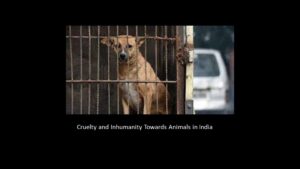Table of Contents
Introduction
Cases of cruelty and inhumanity towards animals are on the rise and what’s being done to stop it? Numerous laws in India were established to safeguard animals and stop cruelty towards them but very few are aware of what they are and how they work.
Cruelty and Inhumanity Towards Animals
To stop animal cruelty, the Central government has passed several laws, the most commendable being the “The Prevention of Cruelty Animals Act, of 1960”. There is the “Wildlife Protection Act, of 1972” as well which was established for the protection of animal species and plants.

The Prevention of Cruelty Animals Act, 1960
The following has been defined as the forms of cruelty toward animals under the Prevention of Cruelty Animals Act, of 1960 in Section 11(1).
(a) Beating, Kicking, Over-riding, Over-driving, Over-loading, Torturing, Causing unnecessary pain or suffering to any animals;
(b) Employing any animal which, because of its age or any disease, is unfit to be so employed, and still making it work or labor or for any purpose;(c) Willfully and unreasonably administering any injurious drug or injurious substance;
(d) Conveying or carrying, either in or upon any vehicle in such a manner as to subject it to unnecessary pain or suffering;
(e) Keeping or confining any animal in any cage or any receptacle, which does not measure sufficiently in height, length, and breadth to permit the animal a reasonable opportunity for movement;
(f) Keeping for an unreasonable time any animal chained or tethered upon an unreasonably heavy chain or chord;
(g) Being the owner, neglects to exercise or cause to be exercised reasonably any dog habitually chained up or kept in close confinement;
(h) Being the owner of any animal fails to provide such animal with sufficient food, drink, or shelter;(i) Being the owner, without reasonable cause, abandons any animal in circumstances, which render it likely that it will suffer pain because of starvation or thirst;
(j) Willfully permits any animal, of which he is the owner to go at large in any street while the animal is affected with a contagious or infectious disease, or without reasonable excuse permits any diseased or disabled animal, of which he is the owner, to die in any street;
(k) Offers for sale or without reasonable cause, has in his possession any animal that is suffering pain because of mutilation, starvation, thirst, overcrowding, or other ill-treatment
(l) Mutilates any animal or kills any animal (including stray dogs) by using the method of strychnine injections in the heart or in any other unnecessarily cruel manner;
(m) Solely to provide entertainment -Confines or causes to be confined any animals (including tying of an animal as bait in a tiger or other sanctuary) to make it an object of prey for any other animal;
Incites any animal to fight or bait any other animal.
(n) Organizes, keeps, uses, or acts in the management of any place for animal fighting or to bait any animal or permits or offers any place to be so used or receives money for the admission of any other person to any place kept or used for any such purposes;
Also, Read 7 Weird Food Laws Around The World
(o) takes part in any shooting match or competition wherein animals are released from captivity for such shooting.
Cruel Treatment of Animals is a Punishable Offense
When an animal is tortured or inflicted cruelty in any of the ways defined under the Prevention of Cruelty Animals Act, 1960 then, the offender is liable to pay a fine which can extend to Rs 50 and if it happens to be a subsequent offence or second offence committed within 3 years of the earlier offence then, the person will get a fine of not less than Rs 25 but which can extend to Rs 100 or with the imprisonment for a term which may extend to three months or with both.
Wildlife Protection Act, 1972
This demonstration is implied for the security of wild creatures and fowls, and some arrangements defend the interests of the creatures.
It restricts the sacrifice of animals, by Section 39 of the Wildlife Protection Act there is a strict disallowance of any damage to the creatures and the punishment is mentioned in segment 51 of the act.
There is likewise a prohibition on keeping any bird of India under the act. If anyone wishes to keep a permissible feathered creature, he needs to consent entirely to Section 11 of the Prevention of Cruelty to Animals Act, 1956
Police powers: Section 50 of the Wildlife Protection Act, 1972 approves a cop to capture any individual without a warrant.
Monkeys can’t be shown or possessed, and are ensured under the Wildlife Protection Act too.
